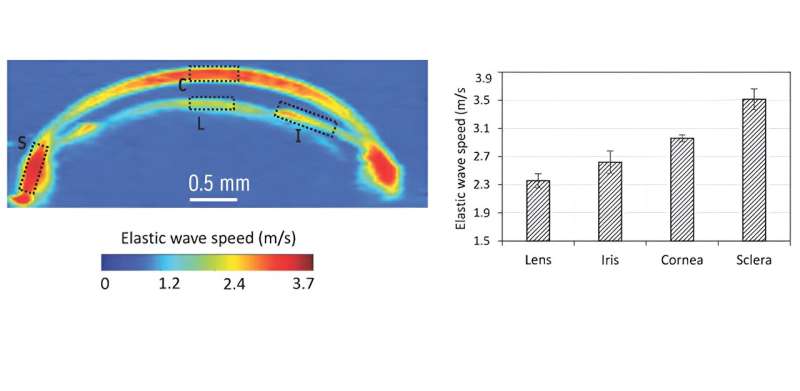This article has been reviewed according to Science X's editorial process and policies. Editors have highlighted the following attributes while ensuring the content's credibility:
fact-checked
peer-reviewed publication
trusted source
proofread
New imaging technique measures elasticity of multiple eye components simultaneously

The eye is a highly complex organ, composed of intricate structures combining several types of specialized tissues. Under normal conditions, these structures work seamlessly together to provide clear images of the world around us as well as maintain intraocular pressure. However, when ocular diseases set in, the biomechanical properties of eye components change, disrupting their normal functioning. Most importantly, the alternations in biomechanical properties of the eye often lead to significant ocular diseases and vision loss.
In order to study, diagnose, and monitor ocular diseases, it is necessary to measure the eye's biomechanical properties, such as stiffness. While several methods have been proposed to this end, most of them are not viable in clinical practice due to their inherent limitations. For instance, magnetic resonance imaging suffers from long scan times, leading to measurement errors caused by the patient's movements; and also comes with a high cost.
Reverberant optical coherence elastography (RevOCE) is a more promising approach in this regard, offering high-resolution measurements of the elasticity or stiffness of the eye's structures. This technique utilizes a low-power light source to scan a target volume and capture the pattern of the mechanical waves propagating through the tissues, using it to create 2D or 3D maps indicative of the elasticity of the region.
RevOCE requires the presence of reverberant shear wave fields—mechanical waves that flood the target volume and produce intricate interference patterns—that are challenging to generate. Currently available methods for this purpose rely on mechanical shakers that must make direct contact with delicate eye tissues.
Against this backdrop, a research team from the University of Houston in Texas is pioneering a new method for the generation of reverberant shear waves that would make RevOCE noninvasive while maintaining superb resolution. Their findings, which could revolutionize how we study the components of the eye and their biomechanical properties, were recently published in the Journal of Biomedical Optics.
In their study, the researchers proposed a custom-built multifocal acoustic radiation force (ARF) system, which employs an ultrasound generator coupled to an array of acoustic lenses as an excitation source. These lenses "channel" the ultrasound waves to create three distinct, focused ARF beams separated by a few millimeters. They mechanically stimulate the target area within the eye, generating reverberant shear waves that can be picked up by an optical coherence tomography device and processed for RevOCE.
The researchers tested their approach on mouse eye globes ex vivo, confirming that it could successfully produce maps of the shear wave speeds within different eye structures simultaneously, including the cornea, iris, lens, sclera, and retina.
Further, a comparative analysis of the results revealed that different parts of the eye, such as the apical region of the cornea and the pupillary zone of the iris, had significantly different shear wave speeds, indicating distinct stiffnesses. Interestingly, different regions within the same eye component, such as the apex and the periphery of the cornea, exhibited variations in shear wave speed. This implies that seemingly uniform structures in the eye have nonuniform biomechanical properties, which could be key to their proper functioning.
Multifocal ARF-based RevOCE has potential to become a powerful tool for improved diagnosis and treatment of ocular diseases. The proposed strategy offers superior resolution compared to previous RevOCE implementations, providing more accurate measurements. It could enable scientists and doctors to analyze the intra- and intercomponent biomechanical relationships among the eye structures.
This, in turn, could enable a more comprehensive understanding of ocular diseases and aging. For instance, this approach could help doctors diagnose and monitor the progression of glaucoma. Moreover, it could be used to assess the effectiveness and side effects of treatments as well as design medical interventions tailored to each patient's needs.
More information: Taye Mekonnen et al, Multifocal acoustic radiation force-based reverberant optical coherence elastography for evaluation of ocular globe biomechanical properties, Journal of Biomedical Optics (2023). DOI: 10.1117/1.JBO.28.9.095001



















